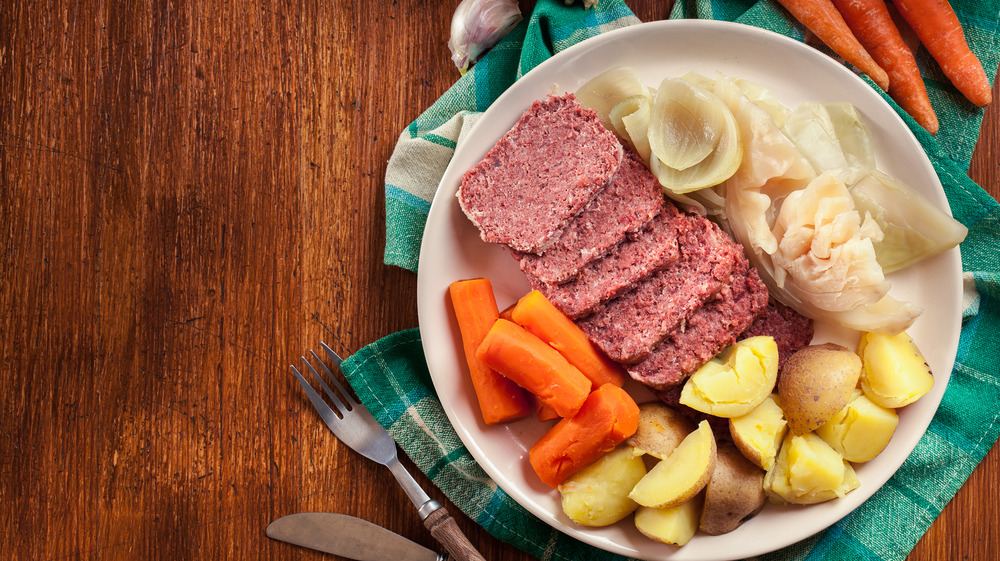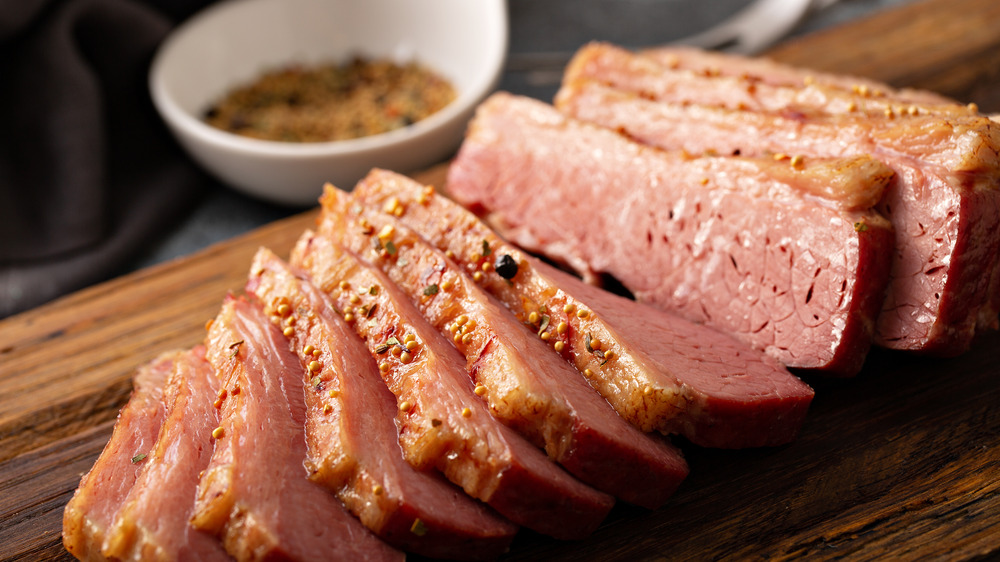Everything You Didn't Know About Corned Beef And Cabbage
Corned beef and cabbage is served on dinner tables across the United States on St. Patrick's Day, and is considered by many to be the quintessential Irish meal. But is it really?
Despite its popularity in the United States, corned beef and cabbage isn't particularly popular in Ireland. Smithsonian Magazine notes that it's not very commonly found there, even on St. Patrick's Day. Like the Hindu view that cows are sacred, similarly, the Gaelic people of ancient Ireland revered the cow. Therefore they were rarely eaten until they got too old to be productive farm animals. "Irish Corned Beef: A Culinary History," posted at the Technological University Dublin, tells us that corned beef was also considered a food of the upper classes, eaten on special occasions and holidays. That would have, of course, included Christmas, Easter and St. Patrick's Day. But most normal folk ate bacon with their cabbage, as it was significantly cheaper than the corned beef.
The Irish beef industry expanded rapidly in the late 1600s, when the British Cattle Acts prevented the import of live cattle, forcing producers to slaughter and cure the meat before shipping. Salt cost almost 10 percent less in Ireland than what it cost in England, making beef significantly cheaper to produce there, according to Smithsonian Magazine.
The term "corned beef" actually originated in England, as the salt crystals the Irish used were roughly the size of a kernel of corn. The large salt grains resulted in meat that's much saltier than what modern palates are used to (via Smithsonian Magazine).
So how did it come to be associated with St. Patrick's Day and Ireland?
Before the legends of snakes and shamrocks, St. Patrick's Day was originally a religious celebration of the so named saint, a British Roman who dedicated his life to bringing Christianity to the Irish (via Britannica). The American Irish adapted the holiday and shaped it into a larger celebration of their heritage and culture, writes Smithsonian. Boston claims to have held the first American St. Patrick's Day parade in the U.S. 1737, according to History.com, and as more celebrations of the Irish culture grew, so did the love of its traditional foods.
However, it wasn't until the late 19th century, reports History, that corned beef and cabbage became synonymous with St. Patrick's Day. When waves of Irish immigrants started coming to the United States during the Great Famine in the mid-1800s, they found that while corned beef was expensive back in Ireland, it was cheaply available in the United States (via Technological University Dublin). Buying the less expensive beef from Jewish butchers, it replaced the bacon or ham they had been using previously in many traditional meals, writes Smithsonian. Cabbage was cheap, and potatoes were an Irish staple, so the combination was flavorful and affordable.
In the ultimate moment that demonstrates the height of corned beef and cabbage's popularity in the States, the non-profit Our White House notes President Abraham Lincoln's inaugural dinner on March 4, 1861 included corned beef and cabbage and parsley potatoes.
Making corned beef and cabbage is not for the impatient
While the classic dish is generally easy to make, according to Martha Stewart, one of the key steps is the brine. While the process takes only minutes of preparation, it requires days of waiting. According to Alton Brown (via The Food Network), you want to soak the meat in a brine for at least 10 days before cooking.
And once that's done, there's still the long cooking time. Traditionally made out of brisket, states The Kitchn, which is cut from the chest area of the cow, the meat has to be cooked for a long time to break down the connective tissue in the muscle and make it tender, notes Food and Wine.
The secret to good corned beef? Along with being patient and letting the meat cook for a long time, you want to then let the meat rest for a bit, then cut it against the grain, notes Spend Your Pennies. Meat specialists UW Provisions concurs, noting that cutting the grain breaks up the muscle fibers in the brisket, so the meat is easier to chew.


